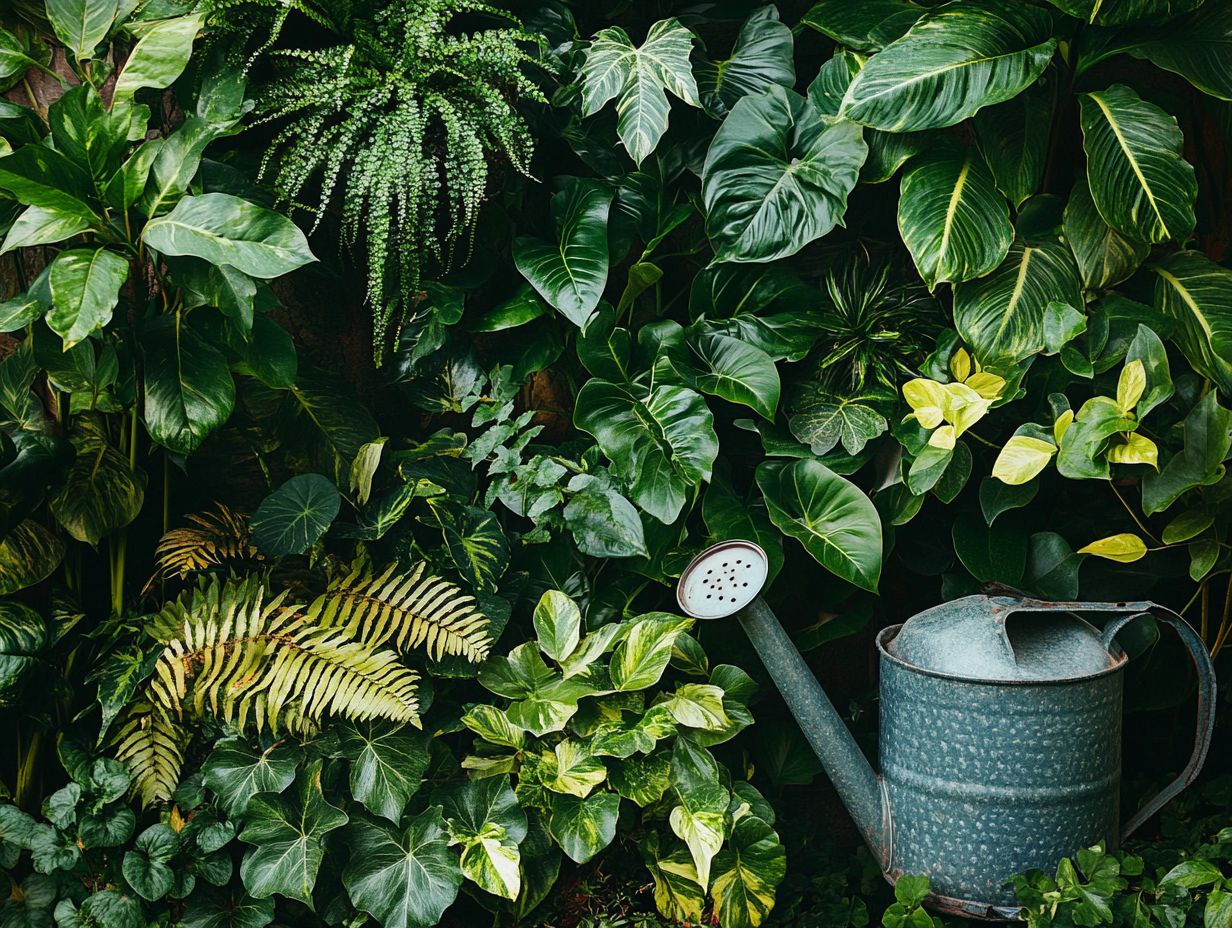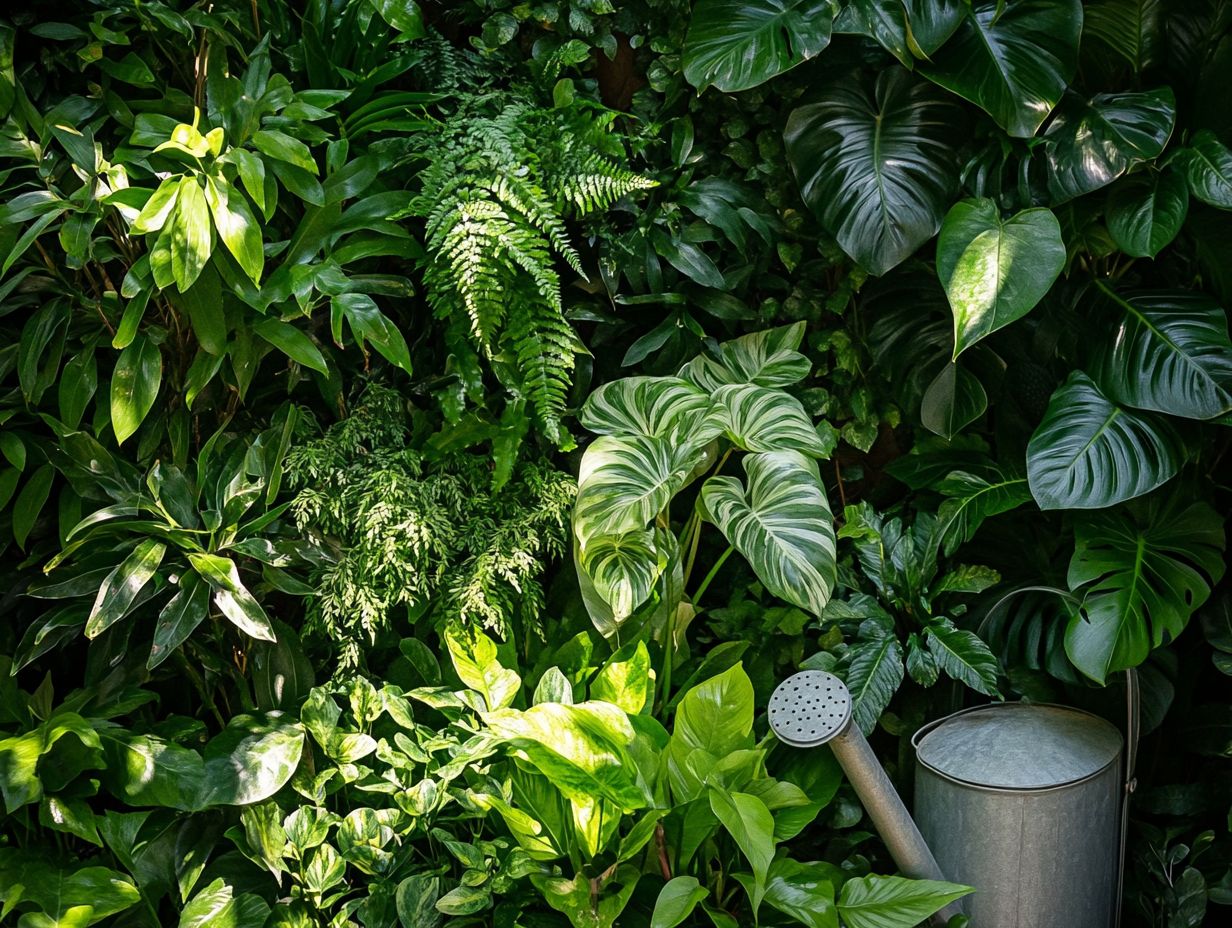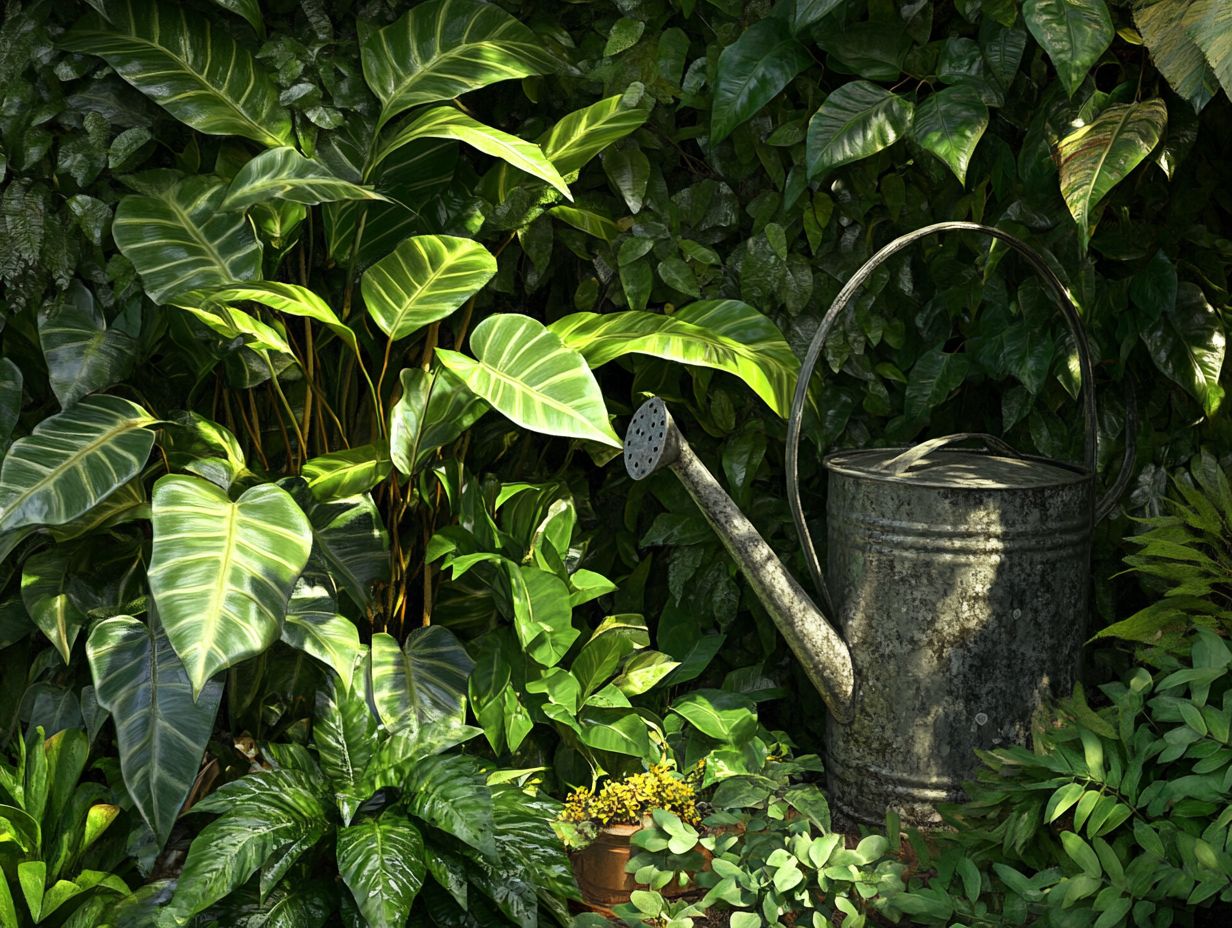Best Eco-Lodges in the Swiss Alps
Foliage plants can transform any space into a lively oasis, adding color and vitality while enhancing air quality and providing significant health benefits.
To keep these green companions flourishing, you must understand their unique requirements for both indoor and outdoor foliage.
This article covers essential care tips, focusing on the best light conditions, watering needs, and soil types that support robust growth. It also highlights the importance of fertilizing and provides strategies for managing pests and diseases effectively.
Whether you re a seasoned plant enthusiast or just starting your botanical journey, you’ll discover valuable insights to help your foliage thrive and enhance your plant care skills.
Contents
Key Takeaways:

- Understanding the light requirements of foliage plants is crucial to their growth and survival. Different types of light can affect plants in various ways, so choosing the right location is essential.
- Proper watering is vital for the health of foliage plants. Factors such as humidity, season, and soil type affect their watering needs. Monitoring these factors helps prevent over- or under-watering.
- Choosing the right soil is essential for the growth and well-being of foliage plants. Different soil types offer varied benefits, such as improved drainage or nutrient retention.
What are Foliage Plants?
Foliage plants, with their lush green leaves and vibrant characteristics, play a crucial role in your indoor and outdoor spaces. They offer an array of benefits, elevating the aesthetic charm of your living areas while enhancing air quality and boosting mental well-being.
You might be drawn to popular varieties such as the snake plant, spider plant, and pothos. These plants are known for their resilience and adaptability, making them perfect for different humidity levels and lighting conditions, whether in your garden or home.
These plants can invigorate any setting, from cozy apartments to sprawling gardens. The snake plant, for example, is celebrated for its air-purifying properties and minimal care requirements, making it ideal for busy lifestyles or beginners.
The spider plant, with its graceful arching leaves and charming baby offshoots, is a delight that’s easy to propagate. Pothos, with its elegant trailing vines, adds a refined touch to shelves and hanging baskets while diligently removing toxins from the air.
When cared for properly, these foliage plants beautify your spaces and foster a serene atmosphere, contributing to a healthier living environment.
Light Requirements for Foliage Plants
Understanding the light requirements for your foliage plants is essential for their growth and overall well-being. Each species has its own preferences and thrives under various conditions from bright, indirect sunlight to low-light environments.
For example, snake plants are remarkably resilient and can tolerate low light, while tropical beauties like monstera thrive best in bright, indirect sunlight. Recognizing these specific needs is key to mastering the art of plant care and ensuring your leafy friends flourish.
Types of Light and Their Effects on Plants
The types of light you choose whether natural sunlight or artificial lighting play a crucial role in the growth and development of your plants. This significantly influences their health and visual appeal.
For foliage plants, grasping the nuances of light spectrum and its impact on photosynthesis the process by which plants convert light energy into chemical energy is important. Different species respond uniquely to varying light conditions, whether they re adorning your indoor spaces or flourishing in outdoor landscapes.
Natural sunlight, abundant in the full spectrum, offers the optimal environment for photosynthesis. This allows plants to truly thrive. On the other hand, artificial lighting, like fluorescent or LED options, can be tailored to mimic these conditions, although their efficiency can differ.
For example, warm white LEDs often suit low-light tropical plants such as snake plants. In contrast, full-spectrum lights deliver the perfect balance for light-hungry varieties like fiddle leaf figs.
By understanding these different types of light, you can make informed choices about which foliage to select for your specific lighting scenarios. Ultimately, this enhances both growth and vibrancy in your green companions.
Watering Needs of Foliage Plants
The watering needs of your foliage plants play a crucial role in their maintenance and overall health. Each species has distinct water requirements that must be addressed for optimal growth.
Striking the right balance between humidity levels and proper soil drainage is essential. For instance, while peace lilies flourish in moist conditions, succulents demand well-draining soil to avoid nitrogen deficiency and root rot. Get to know these details, and watch your indoor garden flourish!
Factors Affecting Watering Needs

Several factors influence your watering needs for foliage plants, including room temperature and soil texture. These elements collectively determine how much water your plants actually require.
Tropical foliage plants often crave more frequent watering due to their love for high humidity, while resilient snake plants can thrive in drier conditions. Humidity is particularly significant; higher levels allow plants to absorb more moisture, while drier air may require you to increase watering frequency.
Temperature also affects watering needs, as warmer environments typically accelerate moisture loss through evaporation. Soil texture is another key player sandy soils drain quickly, meaning you ll need to water them more often, whereas clay retains moisture longer and can alter how much and how often you water.
To keep your plants healthy, check the soil moisture regularly before reaching for that watering can. Consider incorporating plants like Pothos, which flourish in varying humidity, or Peace Lilies, known for their preference for consistent moisture.
Choosing the Right Soil for Foliage Plants
Selecting the ideal soil for your foliage plants is crucial for their vitality and development. The type of soil you choose can profoundly influence drainage, nutrient availability, and root health.
To foster optimal growth, foliage plants typically thrive in well-draining soil that meets their unique nutrient requirements while striking the perfect balance of moisture retention. This is particularly vital for varieties such as ferns and hostas, which flourish in a range of soil textures.
Types of Soil and Their Benefits
Understanding various types of soil is essential for your plant care success. Each type offers unique advantages based on its structure and nutrient makeup.
Loamy soil has a balanced texture, making it perfect for a variety of plants. In contrast, sandy soil excels in drainage, which prevents waterlogging crucial for plants sensitive to excess moisture.
Clay soil retains moisture well and is nutrient-rich, ideal for hardy plants that thrive in wet conditions. If you’re caring for acid-loving varieties, peat soil has a lower pH that many ornamental plants prefer.
To enhance any soil type, add organic fertilizers to boost nutrient levels and overall plant health. Regularly mixing in compost improves structure and fosters beneficial microorganisms, creating a thriving ecosystem.
Fertilizing Foliage Plants
Fertilizing your foliage plants delivers the nutrients needed for robust growth and vibrant leaves. Both macronutrients (major nutrients) and micronutrients (needed in smaller amounts) are essential.
By timing your fertilization well, you can significantly enhance plant health. Ensure favorites like calathea and philodendron get the nourishment they need to thrive.
When and How to Fertilize
Understand when and how to fertilize your foliage plants to ensure their health and full growth potential. Fertilize during the growing season and tailor your approach to each plant’s needs.
For example, using balanced fertilizers during active growth enhances nutrient absorption. Early spring is the ideal time to start this nourishing process.
In this phase, liquid fertilizers allow for quick absorption. As the season progresses, switch to slow-release formulations for sustained nourishment.
Monitor your plant’s leaf color and growth rate to gauge nutrient needs. Also, monitor soil moisture and adjust fertilizer application to prevent root burn.
Pest and Disease Management for Foliage Plants

Take charge of your plant’s health with effective pest and disease management. Infestations can quickly undermine vitality, so be proactive!
Common pests like aphids and spider mites, along with diseases like root rot, pose significant threats. Protect your indoor and outdoor plants for lasting beauty.
Common Pests and Diseases
Common pests like aphids, spider mites, and mealybugs can significantly threaten your beloved foliage plants. Diseases such as powdery mildew and root rot can also hinder their growth and vitality. Identifying these nuisances early is essential for effective plant care. This allows you to intervene promptly and prevent widespread damage.
These unwelcome invaders not only diminish the visual appeal of your plants but can also weaken them. This makes them more vulnerable to additional infestations and diseases. For example, you can spot aphids by their small, pear-shaped bodies, typically clustered on new growth. Spider mites are recognizable by the fine webbing they produce beneath the leaves. Regular monitoring is key. Inspecting your plants weekly will help you catch these issues before they escalate.
Using a mix of methods to control pests like enhancing ventilation, introducing beneficial insects, or opting for organic pesticides can effectively tackle these threats. Maintaining proper watering practices and ensuring your plants receive adequate light will reduce the likelihood of fungal diseases, ultimately enhancing their overall health.
Preventive and Treatment Measures
Implementing preventive and treatment measures is vital for safeguarding your foliage plants against pests and diseases. This ensures their health and longevity. Discover the power of organic solutions, such as neem oil and insecticidal soaps, for effective pest control while fostering sustainable plant care practices.
By incorporating regular monitoring and early intervention, you can significantly decrease the chances of infestations. Encouraging beneficial insects, like ladybugs and lacewings, helps naturally keep pest populations in check.
Along with these organic methods, you might consider chemical options, including systemic insecticides which are absorbed by plants to kill pests from the inside out for severe infestations. Use these responsibly, adhering to label instructions to minimize any environmental impact.
Maintaining proper watering and fertilization techniques plays a crucial role in enhancing your plants resilience. This keeps them robust and less vulnerable to diseases. A balanced integrated pest management strategy that harmonizes both organic and chemical methods is essential for nurturing lush, vibrant foliage.
Frequently Asked Questions
What are foliage plants?
Foliage plants are plants that have leaves as their main feature, rather than flowers or fruits. They are popular for their lush, green appearance and their ability to add a touch of nature to any indoor or outdoor space.
What do foliage plants need to thrive?

Foliage plants have specific needs in terms of light, water, and nutrients. They require moderate to bright indirect light, well-draining soil, and regular watering. Some may also benefit from regular fertilization.
How can I tell if my foliage plant is getting enough light?
Foliage plants need light to photosynthesize and produce energy. If they are not getting enough light, they may start to show signs of stress. This can include yellowing or browning leaves, stunted growth, and wilting. Move your plant to a brighter location if you notice these symptoms.
Do foliage plants need to be fertilized?
While some foliage plants can thrive without fertilization, others benefit from regular feeding. Foliage plants that are actively growing or producing new leaves will benefit from a balanced houseplant fertilizer every 2-4 weeks during the growing season.
How often should I water my foliage plants?
The frequency of watering for foliage plants depends on the specific plant and its environment. It’s important to check the soil moisture before watering, as overwatering can lead to root rot. Generally, most foliage plants need to be watered once or twice a week.
Can I propagate my foliage plants?
Yes, many foliage plants can be propagated through stem or leaf cuttings. Make sure to use a sharp, clean knife or scissors and follow proper propagation techniques for the specific plant. It’s also important to provide the new cutting with the same care and environment as the parent plant.
We encourage you to share your experiences with foliage plants or ask any questions you may have!






